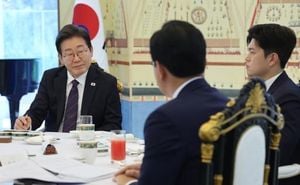Since its premiere on June 5, 2025, the biographical series Chespirito: Sin Querer Queriendo on Max has reignited interest and debate around the life and legacy of Roberto Gómez Bolaños, the beloved Mexican comedian best known for creating iconic characters such as El Chavo del 8 and El Chapulín Colorado. The series delves deeply into both his professional journey and personal life, revealing complex relationships and challenges that shaped his career and persona.
One of the most captivating—and controversial—aspects of the series is its portrayal of Gómez Bolaños's romantic life, particularly his relationship with Florinda Meza, the actress who became his lifelong partner. Their love story, which blossomed amidst professional collaboration, has sparked widespread discussion, especially as Meza herself has publicly criticized the series for distorting key moments of their shared history.
Florinda Meza, renowned for her roles as Doña Florinda, La Chimoltrufia, and La Popis, voiced her dissatisfaction with the series through her Instagram account, declaring bluntly that "it’s not his story." She argued that the production, led by Roberto Gómez Fernández and Paulina Gómez Fernández—Gómez Bolaños's children with his first wife—leans more toward melodrama than truth. Meza lamented the series' Hollywood-style dramatization, saying, "The series can seem romantic because it paints him as a Hollywood-style fighter... but it’s not his story."
In particular, she took issue with scenes like the dramatized moment when Chespirito's character jumps a fence to enter Televisa, asserting, "Roberto Gómez Bolaños was a highly recognized and valued writer in radio, film, and television before creating El Chapulín Colorado and El Chavo del 8. He never had to jump any fence like a delinquent to convince executives. They valued him and wanted to work with him." Meza also disputed the series’ portrayal of her as a conflictive figure, emphasizing instead that their relationship was built on mutual respect, artistic collaboration, and love.
The origins of their relationship, as described in Gómez Bolaños’s autobiography Sin querer queriendo, reveal a more nuanced story. Gómez Bolaños met Meza when she joined the cast of his emblematic programs after her early work in theater and television, including the program La Media Naranja on Canal 8. Their romantic connection began during a work trip, culminating in a quiet, intimate moment at a hotel bar where, as Chespirito recounted, "she and I were the only ones left," leading to their first kiss and the start of a lifelong bond.
However, the relationship was complicated by Gómez Bolaños's existing marriage to Graciela Fernández, with whom he had six children. The couple married in 1968 but separated in 1989, with Gómez Bolaños having been involved with Meza since 1977. He openly acknowledged in his autobiography that his marriage was fractured and that his relationship with Meza began amidst this difficult period. He also admitted to being unfaithful during tours, describing the marital breakdown as a "ditch difficult to cross." Upon separating, he left all shared real estate to Fernández, marking a clear closure to that chapter.
Gómez Bolaños and Fernández’s six children—Cecilia, Marcela, Paulina, Roberto, Teresa, and Graciela—have varying degrees of involvement in preserving their father’s legacy. Notably, Paulina and Roberto Gómez Fernández have taken active roles as producers and writers of Chespirito: Sin Querer Queriendo. Paulina, who once acted in minor roles in her father’s programs and pursued social activism and literary editing, now helps shape the narrative of the series. Roberto Gómez Fernández, the most publicly visible of the siblings, has a long career in television production and has managed the family’s entertainment legacy, including the animated adaptation of El Chavo del 8.
The series also introduces the fictional character Víctor Palacios, portrayed by Manuel Calderón, who stirs curiosity among fans. Palacios is a composite figure, an "amalgam" of various real-life comedians who coexisted with Gómez Bolaños during his early career. This character symbolizes the professional and creative obstacles that challenged Chespirito, compelling him to reinvent himself. Fans speculate that Palacios draws inspiration from iconic figures such as Los Polivoces (Enrique Cuenca and Eduardo Manzano), Arturo "El Bigotón" Castro, Guillermo "El Borras" Rivas, Alejandro Suárez, Manuel "El Loco" Valdés, and Héctor Lechuga, all prominent in Mexican television and theater during the 1960s and 1970s. While the production has not confirmed direct inspirations, the character’s traits and era align closely with these legends.
Amid the series’ release and its mixed reception, Florinda Meza announced her own biographical documentary, Atrévete a vivir, which aims to present her version of the story. Creative director Javi Domz revealed that the documentary is in its final stages after a complete re-recording due to an early leak. Scheduled for release between July and August 2025, the project promises a more personal and authentic portrayal of Meza’s life, from her childhood through her relationship with Gómez Bolaños.
Atrévete a vivir will be groundbreaking in its use of artificial intelligence to creatively reconstruct memories, and it will feature exclusive interviews with artists who worked closely with Meza. The documentary will also explore painful episodes of her life, including childhood violence and familial humiliation due to her acting ambitions. Notably, it will include interviews where Gómez Bolaños’s children acknowledge Meza as the first to believe in them as producers.
Despite tensions surrounding the series, Meza does not intend to pursue legal action against Gómez Bolaños’s children for image use, citing her enduring affection for the late comedian. The official trailer for Atrévete a vivir is set to premiere soon in Times Square, New York, signaling the beginning of a new chapter in the public understanding of these intertwined lives.
Roberto Gómez Bolaños’s life was a tapestry of creative genius, personal challenges, and complex relationships. The contrasting narratives emerging from Chespirito: Sin Querer Queriendo and Atrévete a vivir underscore the multifaceted nature of his legacy. As audiences continue to engage with these stories, the true essence of the man behind the beloved characters remains a subject of fascination, debate, and heartfelt remembrance.






